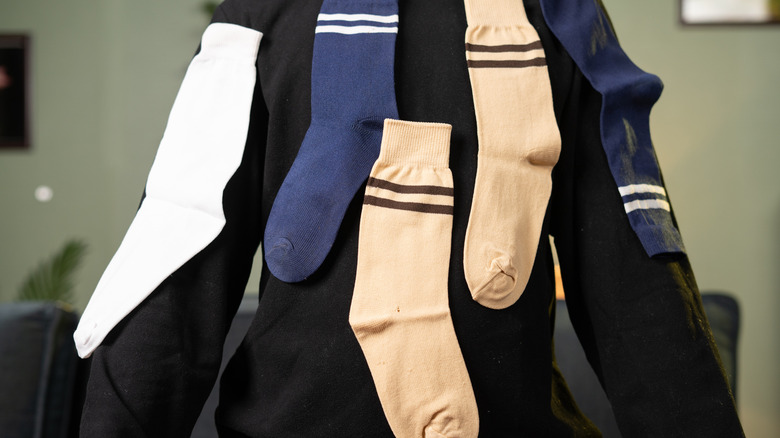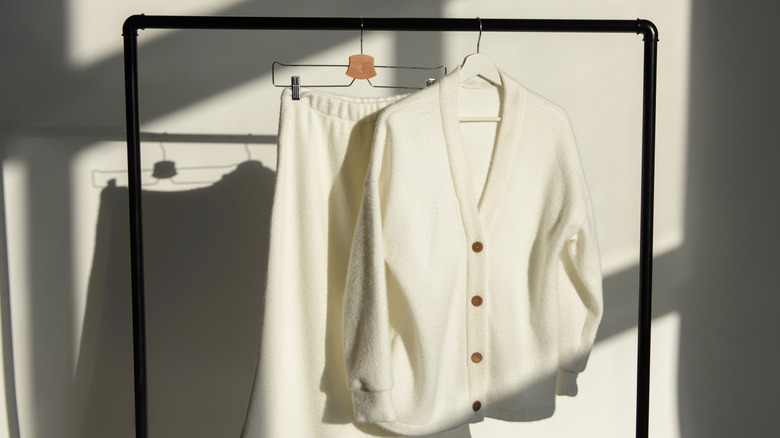The DIY Anti-Static Laundry Spray That's So Easy To Make (But Should You?)
We may receive a commission on purchases made from links.
When you're 8 years old and shuffling across the carpet so you can touch your sister to give her a shock and make her jump, static electricity is fun! When you're older, that charge isn't so amusing, especially if it leads to embarrassment like putting on a sweater you grabbed out of the dryer; as your arm goes through the sleeve, out comes a sock — or something worse — that tagged along on the static electricity express. But perhaps you could stop laundry cling with a DIY anti-static laundry spray that's so easy to make, you can whip one up in a jiffy. The formula includes just witch hazel and essential oils. This differs from the DIY static-cling laundry spray with two common household ingredients, which includes fabric softener. If you are minimizing the chemicals in your life, you'll want to stick with witch hazel and essential oils, both of which are derived from plants.
Start with 1 cup of witch hazel, then add anywhere from five to 30 drops of an essential oil. The types of essential oil used can vary. Lavender is a popular choice, but it's really up to your personal preference. Shake up the concoction in a spray bottle. Then, apply it to the inside of your clothing, paying particular attention to the areas that suffer from the most cling. It's that easy, but should you try it? We couldn't confirm how mixing witch hazel with an essential oil could rid you of static cling, but plenty of people have tried some version of this DIY successfully. If you decide to trust the anecdotal data, it's certainly worth a shot.
Different formulas for the anti-static spray, but do they work?
As you sit reading this, perhaps with staticky pants clinging awkwardly to your legs, you could be wondering if there's a scientific answer to the question of how many drops of essential oil mixed with how much witch hazel will best make those pants hang loose. Unfortunately, academic studies are lacking on the topic, so we turned to anecdotal evidence to see what the user experiences appeared to be. It likewise was scarce, but what we did find was positive.
One Instagram post, which said to add up to 30 drops of an essential oil, had just nine likes and zero shares. Another, which used ½ cup of witch hazel and six drops of lavender essential oil, did attract 33,000 viewers but only 24 comments, including the host's responses. Though there weren't many comments overall, the hosts and those who did respond raved about their sprays. The Organic Beauty Recipes spray called for five drops of oil in 1 cup of witch hazel. When one commenter asked if it worked for anyone, another answered, "I tried it, and it worked well for me."
You might get a chuckle out of knowing that the basic anti-static formula is nearly identical to the one on how to DIY your own budget-friendly Poo-Pourri to banish bad household odors, which mixes 15 drops each of three different oils with 3 ounces of witch hazel. And some of the DIY recipes for linen sprays are closely matched to those of the static cling removal sprays except that the linen sprays don't mention any anti-static properties.
Deciding whether to charge ahead with this anti-static DIY
There are several reasons to give the anti-static laundry spray DIY a try, even if evidence on its effectiveness seems largely anecdotal. First, essential oils smell great, and you can choose ones you like best, so at least you'll smell good while clothes cling to you like wet seaweed. Secondly, witch hazel is inexpensive, so giving this a trial run won't break the bank. And lastly, if it doesn't work out as a static mitigator, you can use it as a linen spray.
There are some drawbacks, though, to testing the witch hazel/essential oil formula. Witch hazel can be an irritant for some people. Also, the oils should not touch the skin at full strength (dissolve them in something like witch hazel or a carrier oil). If you have leftover oils, don't diffuse them into the air if your home is shared with others since allergic reactions can occur. One other caution is that the witch hazel/oil mixture may stain some fabrics. If you're in doubt, test it in an inconspicuous spot.
Meanwhile, to tackle those clingy clothes, if you determined that an anti-static spray isn't your best option or you want to try some other methods, there's one that seems almost too easy. Try getting rid of static on laundry with a simple clothes hanger trick. Running a wire hanger across staticky clothes transfers the static to the metal of the hanger. It's a better idea than calling your little brother to come over and rub his stocking feet against the carpet until he can touch you and zap the static electricity off of you.

